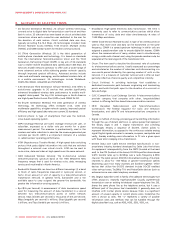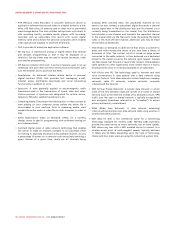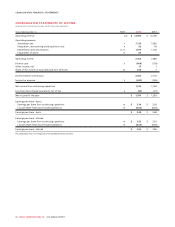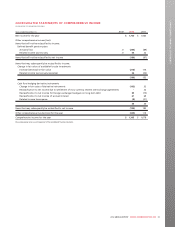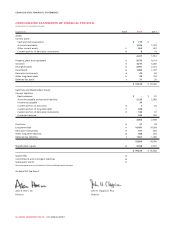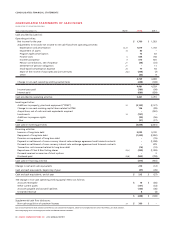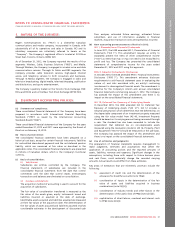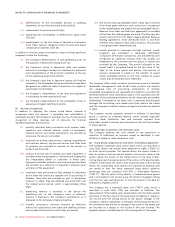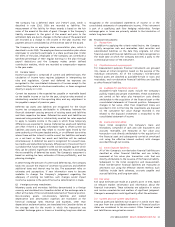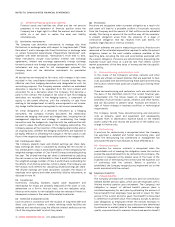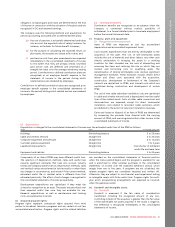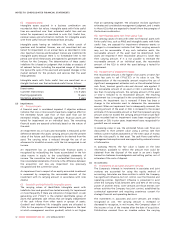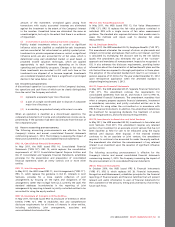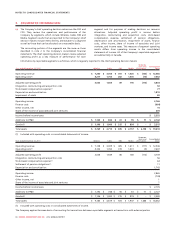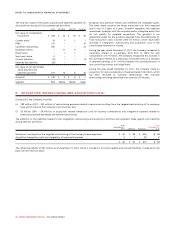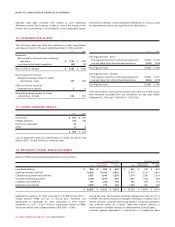Rogers 2012 Annual Report Download - page 92
Download and view the complete annual report
Please find page 92 of the 2012 Rogers annual report below. You can navigate through the pages in the report by either clicking on the pages listed below, or by using the keyword search tool below to find specific information within the annual report.NOTES TO CONSOLIDATED FINANCIAL STATEMENTS
(v) determination of the recoverable amount in assessing
impairment of non-financial assets (note 2(u)(iii));
(vi) measurement of provisions (note 2(p));
(vii) evaluating the recoverability of deferred tax assets (note
2(i)); and
(viii) measurement of the fair value of derivative instruments
(note 19(e)), pension obligation (note 21) and stock-based
compensation liabilities (note 23).
In addition to the key areas of estimation, areas involving significant
judgment include the following:
(i) the Company’s determination of cash generating units for
the purpose of impairment testing (note 13);
(ii) the Company’s choice to depreciate cable and wireless
network on a straight-line basis as it believes this method is
most representative of the economic substance of the use
of the underlying assets (note 2(r)(ii));
(iii) the Company’s view that its Spectrum licenses will likely be
renewed in the foreseeable future and therefore have been
designated an indefinite useful life and are not subject to
amortization (note 2(t)(ii));
(iv) the Company’s interpretation of tax rules and regulations
in calculating income taxes (note 9); and
(v) the Company’s determination of the probability of loss in
assessing contingent liabilities (note 26).
(f) Revenue recognition:
In addition to applying the criteria noted below, revenue is
recognized when the amount is estimable and collectability is
reasonably assured. The Company’s principal sources of revenues and
recognition of these revenues, net of discounts, for financial
statement purposes are as follows:
(i) monthly subscriber fees in connection with wireless, cable,
telephony and Internet services, rental of equipment,
network services and media subscriptions are recorded as
revenue as the service is provided;
(ii) revenue from airtime, data services, roaming, long-distance
and optional services, pay-per-use services and other sales
of products are recorded as revenue as the services or
products are delivered;
(iii) revenue from the sale of wireless and cable equipment is
recorded when the equipment is delivered and accepted by
the independent dealer or subscriber in direct sales.
Equipment subsidies related to new and existing subscribers
are recorded as a reduction of equipment revenues upon
activation of the equipment;
(iv) installation fees and activation fees charged to subscribers
do not meet the criteria as a separate unit of accounting. In
Wireless, these fees are recorded as part of equipment
revenue. In Cable, they are deferred and amortized over
the related service period, which is approximately three
years;
(v) advertising revenue is recorded in the period the
advertising airs on the Company’s radio or television
stations; is featured in the Company’s publications; or is
displayed on the Company’s digital properties;
(vi) monthly subscription revenues received by television
stations for subscriptions from cable and satellite providers
are recorded in the month in which they are earned;
(vii) the Toronto Blue Jays Baseball Club’s (“Blue Jays”) revenue
from home game admission and concessions is recognized
as the related games are played during the baseball season.
Revenue from radio and television agreements is recorded
at the time the related games are aired. The Blue Jays also
receive revenue from the Major League Baseball Revenue
Sharing Agreement, which distributes funds to and from
member clubs, based on each club’s revenues. This revenue
is recognized when determined; and
(viii) awards granted to customers through customer loyalty
programs are considered a separately identifiable
component of the sales transactions, and are deferred until
recognized as operating revenue when the awards are
redeemed by the customer and the goods or services are
provided by the Company. The portion allocated to the
award credit is estimated based on the fair value of the
right to the future goods and services. The amount of
revenue recognized is based on the number of award
credits redeemed relative to the total number of award
credits that are expected to be redeemed.
The Company offers certain products and services as part of multiple
deliverable arrangements, and divides these products and services
into separate units of accounting. Components of multiple
deliverable arrangements are separately accounted for provided the
delivered elements have stand-alone value to the customers and the
fair value of any undelivered elements can be objectively and reliably
determined. Consideration for these units is measured and allocated
amongst the accounting units based upon their relative fair values
and the Company’s relevant revenue recognition policies are applied
to them.
The Company records payments received in advance of providing
goods or services as unearned revenue, which includes subscriber
deposits, cable installation fees and amounts received from
subscribers related to services and subscriptions that will be provided
in future periods.
(g) Subscriber acquisition and retention costs:
The Company expenses the costs related to the acquisition or
retention of subscribers as incurred, except as described in note
2(f)(iv) as it relates to cable installation costs.
(h) Stock-based compensation and other stock-based payments:
The Company’s employee stock option plans, which are described in
note 23(a), attach cash-settled share appreciation rights (“SARs”) to
all stock options granted. This feature allows the option holder to
elect to receive in cash an amount equal to the intrinsic value of the
option, being the excess of the market price of the Class B Non-
Voting share over the exercise price of the option at the exercise date,
instead of exercising the option and acquiring Class B Non-Voting
shares. All outstanding stock options are classified as liabilities and
are carried at their fair value, measured using option valuation
techniques that are compliant with IFRS 2, Share-based Payment
(“IFRS 2”). The fair value of the liability is remeasured each period
and is amortized to net income using the shorter of graded vesting
over the four year vesting period, or over the period to the date an
employee is eligible to retire.
The Company has a restricted share unit (“RSU”) plan, which is
described in note 23(b). RSUs are recorded as liabilities. The
measurement of the liability and compensation costs for these awards
are based on the fair value of the award and recorded as a charge to
net income over the vesting period of the award. Changes in the
Company’s liability subsequent to the grant of the award and prior to
the settlement date are due to changes in fair value of the award and
are recorded as a charge to net income in the year incurred. The
payment amount is established as of the vesting date of the award.
88 ROGERS COMMUNICATIONS INC. 2012 ANNUAL REPORT


